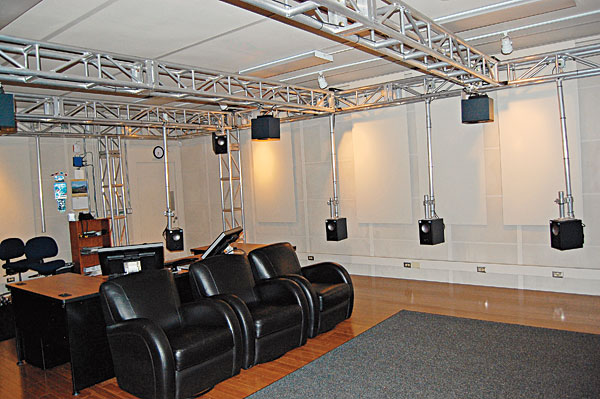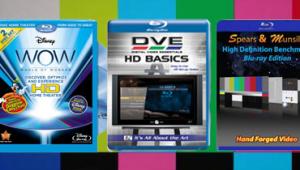Tech Spotlight: SRS & The Future Of Surround

Like most Home Theater readers, I’ve known SRS Labs primarily as the company that does virtual surround sound and other audio solutions for HDTVs and soundbars—features largely dismissed by serious enthusiasts as lightweight hocus-pocus. So it was with some skepticism that, back in March, I rolled into the firm’s Santa Ana, California, headquarters for a private demo of some new surround sound technology.
After the preliminaries, I was led to the company’s Advanced Rendering Lab, a big room equipped with powered studio monitors crossing every wall and firing down from the ceiling—22 of them in all. There was a big flat panel mounted on the far wall and a computer workstation behind the listening seats where SRS engineers could trot out their latest algorithms to test them with whatever configuration of speaker channels they wished.
Here, sitting in the sweet spot up front, I watched a couple of clips from Avatar delivered with what was certainly the most different—if not the best—surround sound I’ve ever heard. The width, height, and, especially the depth of the soundstage were simply breathtaking. The ambience of these outdoor fight and combat scenes was seemingly boundless, to where I could not readily localize the presence of any speakers or even the walls of the studio space. The action moved effortlessly across the front and sides of the room, and occasionally toward the back, and reached surprisingly deep into the area between and above me and the screen.
I was struck by how individual sounds always remained etched and delineated spatially from others within the soundfield, even as they moved, and by the tremendous amount of sonic detail this revealed. Particularly intriguing was how the background music—the one part of most soundtracks that doesn’t directly communicate action on the screen—remained perfectly isolated and anchored above and well forward of the screen, as though emanating from virtual speakers suspended in the space.
You could point at it. At that moment, the metaphoric light bulb above my head popped on, and I thought, “Well, the music doesn’t convey action—of course it belongs on its own shelf.” And it dawned on me how poor the typical surround system is at keeping the music and individual audio elements of a soundtrack spatially distinct from one another. I suddenly understood how unique this was.
Now, here’s the kicker: All that sound came from just two forward-firing speakers and a subwoofer.
The New Surround
What I heard that day at SRS was a witch’s brew of breakthrough audio technologies, a combination of new psychoacoustic depth-rendering techniques applied through the filter of a game-changing approach to mixing movie soundtracks that SRS calls Multi-dimensional Audio, or MDA. Together, they form the basis of CircleCinema 3D, a feature that will begin appearing in flat-panel HDTVs and soundbars from SRS licensees in 2012, and perhaps later, in A/V receivers.
Conceptually, MDA eschews the limited notion of traditional multichannel-based sound mixing, which relies on ever-shifting differences in the volume or amplitude of each channel’s signal to push and pull audio objects across a soundfield patched together from five, seven, or more speakers. With MDA, a movie soundtrack is instead created in a virtual, three-dimensional audio space with no regard for how many speakers or what processing technologies might be used later to play it back. Metadata tied to each audio object provides detailed information from the creator about how that object moves and behaves. That metadata can then be applied, either immediately or even decades later, to however many channels or whatever sound processing technologies are available or might come along. Not only does MDA make a movie’s soundtrack mix future-proof in this regard, but it solves the costly problem studios face today of having to create entirely separate mixes for five-channel, seven-channel, or other playback configurations. With an MDA-based soundtrack, the theoretically ideal soundtrack gets mixed just once, and different, wholly discrete versions can then be generated from the metadata with something akin to pushing some buttons.

To promote the creation of new movies in MDA, SRS has founded the 3D Audio Alliance, or 3DAA, a fledgling organization that’s working first with the Hollywood sound community to expose and further develop the technology. But even without waiting for fresh MDA soundtracks, the company is reaping the benefits of its MDA research by bringing CircleCinema 3D to market as an enhancement for legacy content. The CC3D architecture includes a software module that can analyze an existing 5.1-channel or stereo soundtrack and generate the MDA metadata based on assumptions of where the content creator might have placed things within a full 3D space. It was this kind of deconstruction, applied to Avatar, that I heard in the Advanced Rendering Lab. As the clips were played, the original multichannel soundtrack was analyzed on the fly and the resulting metadata tapped to direct psychoacoustic depth-rendering of specific objects. The overall effect was the illusion that I was inhabiting the movie in a way I’ve never felt with conventional surround sound.
To learn more about MDA and CircleCinema 3D, I spoke with Alan Kraemer, SRS’s chief technology officer and driving force behind these technologies and the 3DAA.
RS: Where did this whole idea of MDA, of attaching metadata to audio objects, come from initially?
AK: Twice a year, we get together for internal off-site technical meetings, and it was at one of those meetings about two years ago that we came up with this concept and decided to explore it further. We realized that, in order to really create a true representation of a soundfield, we needed more information than what [amplitude-driven] channel-based audio currently provides. So the core concept was to move away from the multichannel surround paradigm, which has been in existence for about 70 years since Walt Disney first came up with the idea for Fantasia. Basically, all we’ve done since is changed the plumbing and put speakers in different positions. But there’s this continuous arms race with two-channel, then 5.1, then 7.1, then 11.2, then 22.3, or whatever. None of those things are very satisfying, and they also involve arbitrary decisions about where the speakers are located and how you mix for those configurations. And every time those configurations change, that movie has to be remixed.




























































